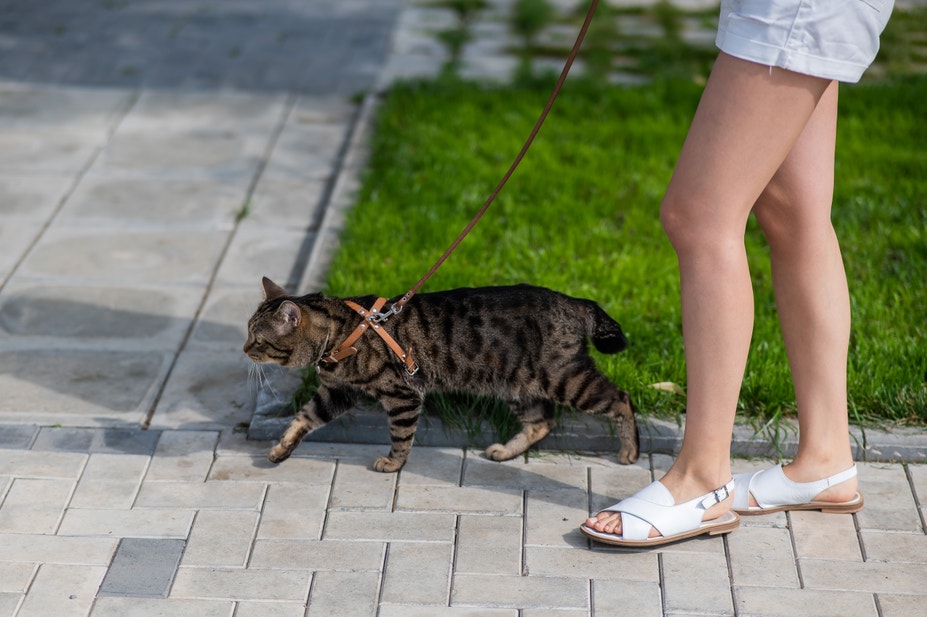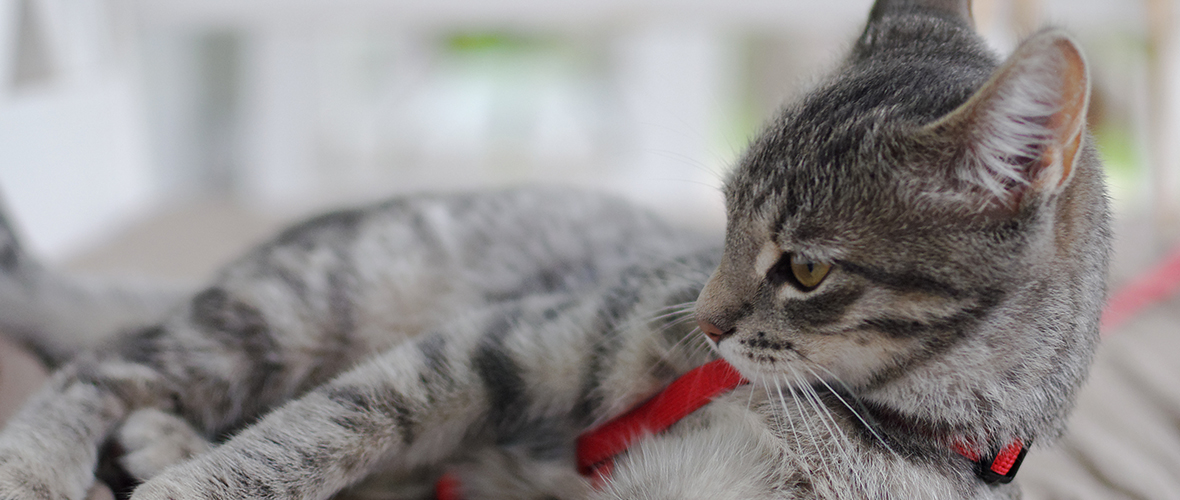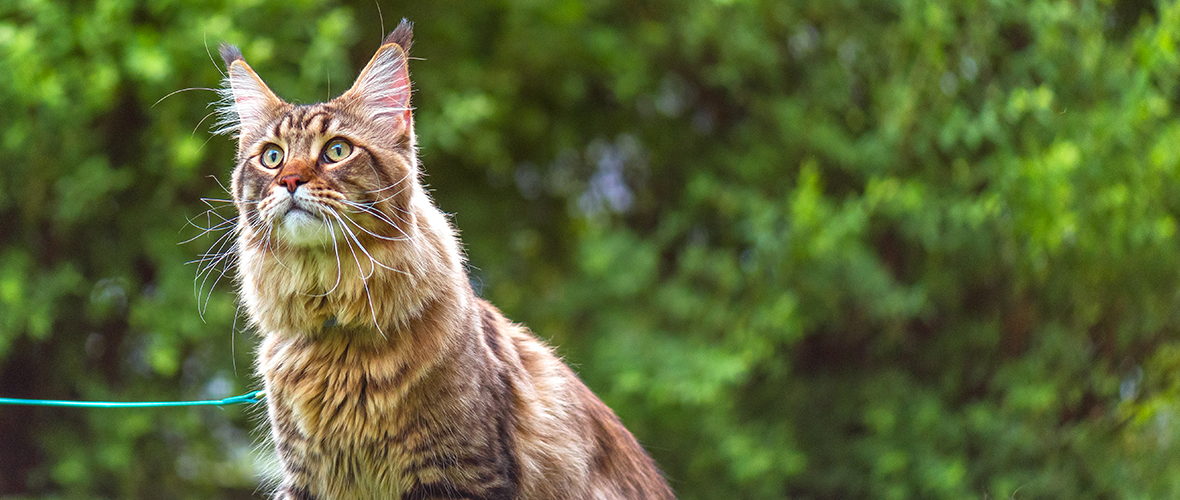
HOW TO TAKE A CAT FOR A WALK: HARNESS TRAINING YOUR CAT
Walking a cat on a lead has become increasingly popular around the world, providing health benefits for both owners and their pets with physical exercise and a boost to a cat’s mental health. That being said, the majority of cats will HATE being on a collar and lead or a harness, as it goes against their natural instincts. Therefore, we do NOT recommend this for the majority of cats.
In some cases, walking a cat may be necessary. However, harness training a cat is different to harness training a dog, requiring different equipment and processes. With time and practice, you and your cat can enjoy the outdoors together.
All cats are different, with some picking up harness training quickly, whilst others struggle or refuse to wear a harness. That being said, walking a cat with a harness can be an enriching experience, helping you build a strong bond with your cat. Not only that, but walking a cat on a lead using a harness reduces strain on their neck compared to traditional collars.
Can you walk a cat? Only in some circumstances. For a minority of cats, or where it is the only option or safest way, walking cats on leads may be required.
If you are still wondering, ‘can you walk a cat?,’ and are looking for tips for harnessing a cat and walking cats in harnesses, we have a complete guide here. We will be discussing how to put on a harness on a cat and guiding you through the top tips for harness training a cat.
Rather than walking cats on leads, we will also be discussing more reliable methods of transport for cats, such as secure baskets.
What You Need for Lead Training a Cat
Harnessing a cat requires very little. You can choose from a range of harnesses, but you must ensure it is well-fitted and comfortable for your cat. Leads also come in different designs, but a retractable lead or one with a shorter design and some slack is recommended.
When you begin to walk a cat on a lead, look out for any behavioural cues. As most cats hate being on leads, you should only continue if your cat appears happy and content.
It is best to use a shorter lead when you first walk a cat before moving onto a design that provides more freedom. This type of lead will keep your cat close by, reducing the risk of your cat escaping or moving uncomfortably.
You should never attach a lead to a cat’s collar as this can become a choking hazard when pulled. Adjustable collars are not advised because once it breaks away, you will not be connected to your cat. A full harness is the only option, providing added safety and comfort for your cat.
Always keep in mind that most cats will not enjoy wearing a harness, and it may cause unnecessary stress.
When you start walking the cat on a lead, give them some treats to help calm their possible anxiousness and form a positive association with the unknown object. You can also leave treats on top of the harness to attract them to it if they are hesitant. Carrying a bag with treats, water, and the removal of waste is also recommended.

Walking a Cat on a Lead: Is It Really Possible?
“Can you walk a cat?” has been a common debate for many years, with many believing harnessing a cat to be unnatural. A common misconception is that putting a cat on a lead and walking it is impossible, but this is not the case. It is true that many cats do not like being restrained, especially over long periods of time, but some, such as Siamese cats and some indoor cat breeds, are more likely to tolerate a lead.
Walking a cat on a lead is feasible, but only when the right harness is used and training is completed properly. In most cases, it is recommended to introduce a harness slowly when a cat is young, allowing them to adjust and get used to wearing it.
There are success stories of walking a cat with a harness, such as Figaro, a Maine Coon cross Ragdoll, who was successfully trained to walk on a lead. After Figaro’s owner lost her previous cat to an accident, these daily walks positively impacted her mental health, highlighting the effects cat walking can have on both pet and owner.
How to take your cat for a walk using a harness & lead
Before you take your cat out for a walk, you must learn how to put on a harness on a cat. Remember, harnessing a cat is not suitable for all, as this can cause stress in many cats. If this is the case, it is recommended that you find alternative methods of exercise for your cat, as seen here.
Here is a step-by-step guide for how to put a harness on a cat and tips to walk a cat on a lead.
- Start by finding a secure, comfortable, and well-fitted harness specifically designed for cats. Do not put it on your cat immediately.
- Next, place the harness on the ground, waiting for your cat to feel calm enough to investigate it. When they start to inspect the harness, reward your cat with a treat.
- Once your cat is comfortable around the harness, try and poke their head through it by holding your cat up. Once the harness is on, reward them with a treat.
- If your cat is comfortable, start to gently place the harness on their body but do not do it up. Once again, give your cat a treat when they are wearing the harness and then take it off. When the harness is on again, try to do it up and allow your cat to walk around with a lead attached, and continue to give rewards.
- Repeat this over a few days until your cat seems excited to see the harness. Only then should you attach the lead before walking them around your home, lured by a treat or toy.
- After your cat has become used to the harness indoors, it’s time to try taking them outside. Start in safe, quiet spaces, and carefully monitor your cat’s body language. If they become anxious or stressed, repeat the earlier training steps. All cats are different, so you will need to work at individual paces for their individual needs.
Bear in mind that it is not natural to walk cats in harnesses. If necessary, however, harness cat training typically takes time. Each training session should only be performed in short bursts, when your cat is in the mood.

How to put a harness on a cat safely
When putting a harness on a cat, you should read the directions that came with the harness. Typically, most cats will be fidgety when you try placing the harness on at first, but by following the correct steps, you can help encourage confidence and comfort, making harness training your cat a positive and stress-free experience.
Here’s a recap of how to put a harness on a cat safely:
- Place the harness in a familiar spot for your cat, such as a feeding spot or their favourite napping space.
- Slip the harness over their head when they are used to it.
- For a vest harness, place it over your cat’s back before fastening the clips located on the midsection and neck. If you have a H-style harness or figure of eight design, fasten the neck straps and secure the back and midsection straps.
- Walk around your house to allow your cat to get used to wearing the harness in their natural habitat.
You may need help from someone when placing a harness on a cat for the first time, having one of you hold the cat, whilst the other places the harness on. If your cat seems uncomfortable and wriggles a lot, it’s a good sign that they do not like it or the harness is too tight. If so, do not carry on trying to place the harness on as this can cause stress, leading to possible behavioural issues.
Best practices for walking your cat on a lead
When it comes to harness cat training and walking a cat with a harness outdoors, you need to consider a few factors, including the time you take your cat out and where the walk takes place. Some stimuli that can be especially triggering for cats, such as traffic, other animals like dogs, and various loud noises, should be avoided to avoid stress and unease.
You should choose a dry, temperate day to start walking your cat in a harness outdoors. Start by guiding them to the door with a treat. Certain behaviours like kneading may indicate your cat is hesitant or frightened. If this occurs, do not force them to go outside. Stop, and try again the next day.
Take treats with you on your walk but keep it to only a few minutes at first. Over time, you can increase the walk durations to 15 to 30 minutes every day or every other day.
Best Cat Harnesses for Lead Walking
Before walking a cat with a harness, you must choose the right type when lead walking. There are many different types of cat harnesses for walking, but the three most popular are:
- Vest harness
- H-style harness
- Step-in harness
A vest or jacket harness is designed to loop around a cat’s neck and belly, leaving room between their front legs for movement and flexibility. The material and thickness of a vest harness is similar to a cat collar, with some featuring padded mesh for added comfort and security.
A h-style harness has adjustable buckles, with a band that fits around a cat’s stomach and another around its neck. These are connected by another strap in the midsection, forming a ‘H’ shape.
The step-in design is considered the softest and most comfortable cat harness for walking. Typically made with padded material with clips or Velcro for fastening to a cat’s stomach or back, the step-in harness keeps a cat secure at all times.
Quick Tips on walking your cat
When you walk a cat, there are some steps you can take to ensure it goes smoothly and your cat doesn’t get too stressed. Here are some common questions and helpful tips for walking cats on leads.
Lead Training Your Cat: A Step-by-Step Introduction
- Place the harness on the floor, gradually luring your cat to inspect it with treats (do not force your cat to the harness).
- Carefully place the harness on your cat and train walking with them to walk around your house. Use treats for positive reinforcement.
- Once your cat is confident and comfortable with the harness and lead, take them for a short walk outside in a quiet area. Over time, increase the walk duration to around 15 to 30 minutes each day or every other day.
Cat Walking Harness Types
The main types of cat harnesses for walking are:
- H-style
- Y-style
- Vest style
- Jacket style
Consider your cat’s size, breed, coat length, activity level, and any medical conditions when choosing a cat harness for walking. Adjustable harnesses are best for growing kittens, whilst longer-haired cats should avoid heavy coverage designs or those with Velcro.
Vest-style harnesses are recommended for longer adventures, whereas minimal designs are best for short walks or vet trips.
Rather than using a lead, collar, or cat harness for walking and transportation, we advise a secure cat carrying box for a visit to the vets for the cat's safety.
Before taking your cat on a lead, consult with your veterinarian if your cat has any health concerns, such as arthritis or asthma, as some harness types may cause discomfort.
